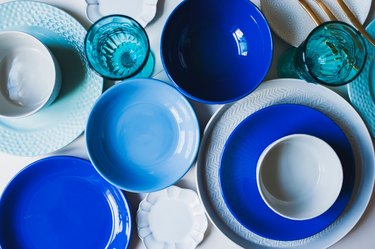
Stoneware can crack or break over time for many reasons, but unlike Humpty Dumpty, you can put it back together again. Before settling for the last resort of tossing it in the trash, try these ways to repair cracked stoneware.
Apply the Philosophy of Kintsugi
Video of the Day
The philosophy of the Japanese art of Kintsugi states that you can repair broken pottery with an adhesive gilded lacquer. The gilded lacquer can come in a variety of metallic colors such as gold, silver or platinum. The word Kintsugi means "golden repair" and "golden joinery" according to Southern Living. The philosophy incorporates seeing the cracks and embracing them with gold or color instead of trying to hide them. The crack becomes part of the pottery and its beauty.
Video of the Day
This philosophy dates back to 1400s Japan as a method to repair broken china. Instead of throwing away broken pottery, embrace the broken pieces becoming whole again both visually and metaphorically. The cracks and chips make it more beautiful, and what's broken can become whole again.
Mend the Broken Pieces
Lakeside Pottery recommends using cold materials and process to fix broken pottery and repair hairline cracks in pottery. You can put the pieces back together with a two-part epoxy adhesive. Before you begin, clean the pieces with alcohol. To keep the pieces in place, fill a small container with sand, rice or plastic pebbles. Place the largest broken piece in the container to keep it secure. Put a small amount of the 5-minute clear epoxy on a piece of cardboard or paper so you'll have more control over it. Mix the epoxy thoroughly with a wooden stick, paper clip or pin tool.
Next, apply the epoxy mix to the edge of the pottery using the tool. Gently set the broken piece on the epoxy. The epoxy dries very quickly, within about 60 to 90 seconds, so work quickly because once it starts to dry it becomes less sticky and won't work properly. Apply a small amount of pressure to seal it and squeeze out any extra epoxy. Don't wipe off any overflow epoxy since it will smear on the pottery.
Let the epoxy dry for 20 minutes. If you're placing another broken piece on top of the epoxy, wait 20 minutes so that it's strong enough to support the additional weight. Allow the epoxy to cure at 75 degrees Fahrenheit or higher. If the pieces don't hold well by gravity alone, you can apply a small amount of clay to temporarily seal it together.
If there's any extra epoxy on the pottery, use a razor blade to gently scrape it off. Always wear protective eyewear. Bending the razor blade may allow for easier removal. Clean the pottery surface with alcohol to allow the filler to bond.
Apply Filler
The next step in Lakeside Pottery's repair process is applying ceramic filler. Before you begin, make sure to clean the surface thoroughly with 91 percent alcohol. The alcohol will remove any oil from your hands and dust that got on the pottery while adhering the broken pieces together. Next, mix even parts of PC-11 epoxy filler and apply a thin layer. Make sure to push it into any cracks. Let the epoxy filler set for at least 12 hours to dry. It sets best at 75 degrees Fahrenheit or warmer.
Sand and Repaint
After the epoxy filler has set for 12 hours or more, it's time to sand it. Always wear protective eyewear when sanding. Lakeside Pottery recommends using a Dremel EZ lock sanding disc 120 grit. Use low speed and gently apply a small amount of pressure. This will prevent burn marks. You may also want to sand by hand with sandpaper. Lakeside Pottery recommends starting with 220-grit sandpaper and ending with 400 grit. Clean the stoneware again with alcohol to remove any dust, sand and oils. Lastly, repaint the pottery if needed to blend in the cracks and filler. Try and match the paint as closely as possible.